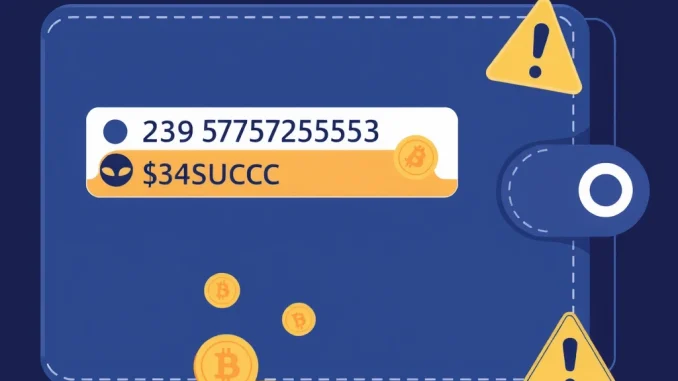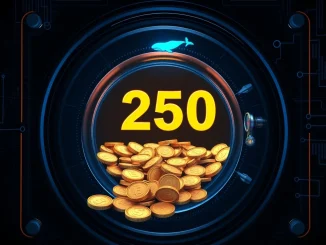
Imagine logging into your crypto wallet, ready to send funds, only to realize you’ve accidentally sent $100,000 to a scammer. This devastating scenario is exactly what happened to a user recently, highlighting the growing threat of the address poisoning scam in the crypto space. It’s a cunning trick designed to exploit a common user habit, leading to significant USDC loss and other crypto assets.
What is an Address Poisoning Scam?
The address poisoning scam is a sophisticated form of phishing that preys on users’ reliance on checking only the first and last few characters of a wallet address when sending transactions. Scammers execute small, zero-value transactions (often 0 ETH) from an address that looks remarkably similar to the victim’s or a frequently used contact’s address. The scammer’s address is crafted to have the same beginning and end characters as the legitimate address.
Here’s how it typically works:
- The scammer identifies a potential target who frequently transacts with a specific address (e.g., an exchange deposit address or a friend’s wallet).
- The scammer generates a wallet address that mirrors the beginning and end of the target’s or their contact’s legitimate address.
- The scammer sends a tiny, often zero-value transaction from this look-alike address to the victim’s wallet.
- This transaction appears in the victim’s transaction history.
- Later, when the victim wants to send funds to the legitimate address, they might copy the address from their transaction history instead of their address book or a trusted source.
- Because the scammer’s address looks so similar, the victim might mistakenly copy and paste the scammer’s address from the history.
- The victim sends funds to the scammer’s address, thinking it’s the legitimate one.
The $100K USDC Loss Incident
This exact technique was reportedly used in a recent incident highlighted by Cyvers Alerts on X. According to their report, a user fell victim to an address poisoning scam, resulting in a substantial USDC loss of $100,000. The attacker was quick to act, immediately swapping the stolen USDC loss funds for DAI, likely to make tracing and recovery more difficult.
This incident serves as a stark reminder that even seemingly small, innocuous transactions in your history can be part of a larger scheme targeting your assets. The attacker’s speed in swapping the funds underscores the need for immediate action and robust security measures.
Why is This Crypto Scam Effective?
This particular crypto scam is effective because it exploits a common shortcut users take. Verifying a full, long hexadecimal wallet address every single time is tedious. Users get used to quickly checking the start and end. Address poisoning leverages this habit by making the fake address pass this superficial check. It’s a social engineering tactic layered on top of a technical trick, making it a dangerous form of crypto scam.
Enhancing Your Wallet Security Against Address Poisoning
Protecting yourself from this type of crypto scam requires diligence and adopting safer habits. Improving your wallet security is paramount in the face of evolving threats like address poisoning. Here are key strategies:
Always Verify the Full Address
This is the most critical step. Before sending any transaction, especially for large amounts, force yourself to verify the *entire* recipient address, not just the beginning and end. Double-checking character by character might seem excessive, but it’s the most reliable way to prevent sending funds to a scammer’s look-alike address.
Use Address Books or Whitelists
For addresses you frequently send to, save them in your wallet’s address book or create a whitelist. When sending, select the address from your trusted list rather than copying from transaction history. This bypasses the risk of copying a poisoned address.
Consider Hardware Wallets
Hardware wallets add an extra layer of security. Often, they require manual verification of the recipient address on the device screen itself before signing a transaction. This makes it harder to fall victim to copy-paste errors induced by address poisoning.
Leverage AI for Crypto Safety
As mentioned in the Cyvers report, exploring AI-based security tools can provide additional protection. These tools can potentially analyze transaction patterns, identify suspicious addresses or behaviors, and alert you to potential risks before you confirm a transaction. While not foolproof, they add another layer to your overall crypto safety strategy.
Actionable Steps for Better Crypto Safety
To summarize how to protect yourself and prevent potential USDC loss or loss of other assets from an address poisoning scam, follow these steps:
- Educate Yourself: Understand how address poisoning works.
- Verify Meticulously: Always check the *entire* recipient address before sending.
- Use Address Books: Rely on saved, verified addresses for frequent transactions.
- Stay Suspicious: Be wary of unexpected tiny transactions in your history.
- Explore Tools: Look into security tools, including potential AI-powered solutions, that offer address verification features.
Conclusion
The $100,000 USDC loss due to an address poisoning scam is a harsh reminder that vigilance is key in the world of cryptocurrency. Scammers are constantly evolving their tactics, and the simplicity yet effectiveness of this particular crypto scam makes it a significant threat. By prioritizing robust wallet security practices, meticulously verifying addresses, and staying informed about the latest threats, you can significantly enhance your crypto safety and protect your valuable assets from falling into the wrong hands. Don’t let convenience compromise your security – a moment of careful verification can save you from a devastating loss.



